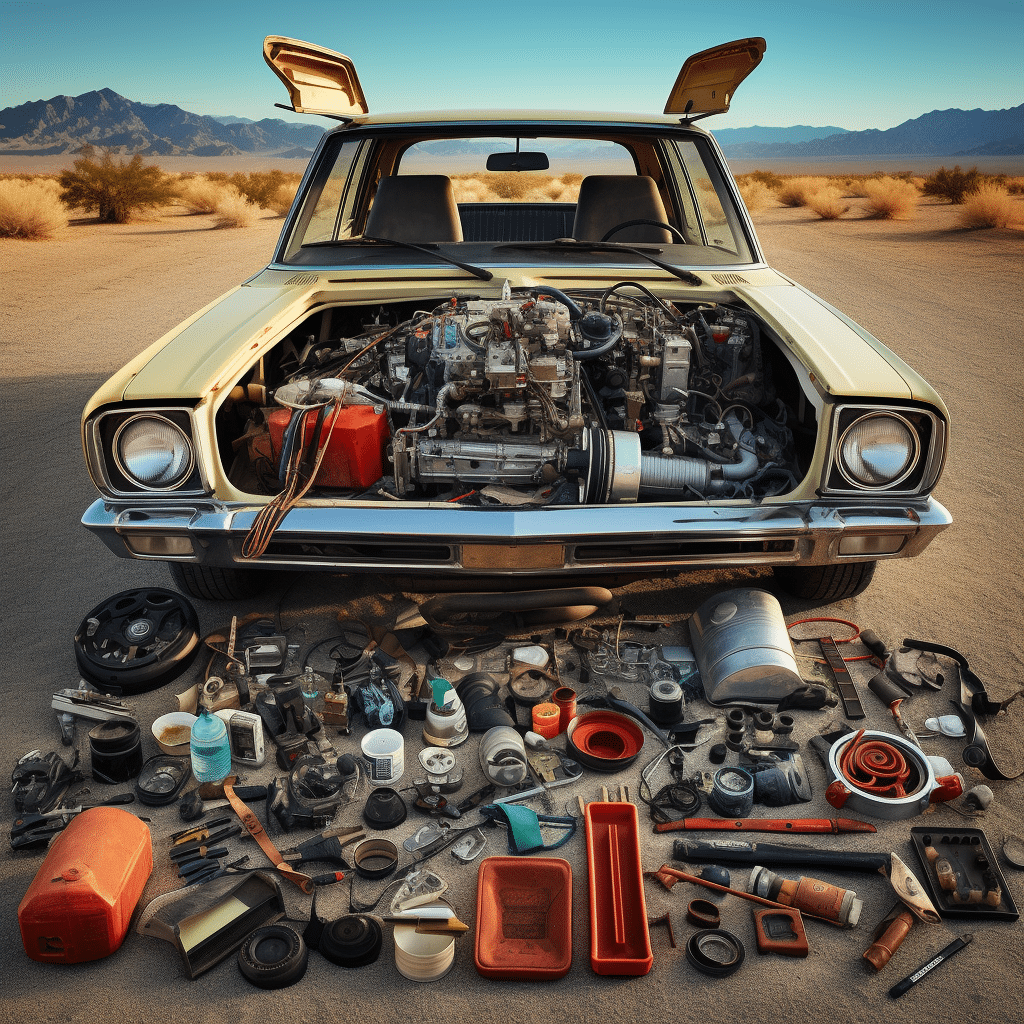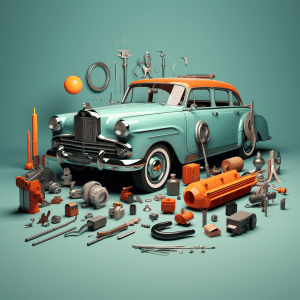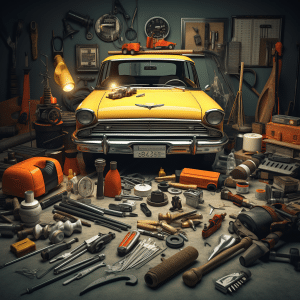
Essential Car Tools: Importance and Tips
Buying a car? Think about the tools. Do they come with it? It depends. Some car makers include basic sets – jacks, lug wrenches, and maybe screwdrivers or pliers. Handy for simple tasks or changing tires. But not all cars come with them. Maybe the manufacturer wanted to lower costs or thought most owners wouldn’t need them. So if not, car owners need their own set.
In the past, tools were often standard when cars were simpler and easier to work on. As cars became more complex, manufacturers phased out the inclusion of tools. Now, some models still come with a set, but it’s less common. The assumption is that people either have their own tools or can get them when needed.
Importance of Tools in a Car
Tools in cars are very important. Emergencies or repairs? Having the right tools can save the day. Changing a flat tire or jump-starting a dead battery? A fully-equipped toolbox in your car makes a difference.
Tools are also important for regular car maintenance. Checking and adjusting tire pressure? Topping up fluids? Maintenance tasks can be done at home if you have the right tools. This saves time and money and keeps your car running well.
Essential tools for every car toolkit:
- jack
- lug wrench
- jumper cables
- flashlight
- multi-tool
These items can help you with common emergencies and repairs.
Not all cars come with these tools. Some models might have a basic tool kit, others none. Check what tools are included when you buy a new or used car. Consider adding any missing items to your own toolkit.
Did you know? According to Consumer Reports, only 40% of new vehicles come with a full-sized spare tire. Many drivers don’t have the necessary tools to handle a flat tire.
Basic Tools that Come with a Car

Essential tools are a must for any car. These provide convenience and peace of mind to drivers. For instance, tire irons or lug wrenches help with changing flat tires. Jacks enable drivers to lift the car off the ground for wheel changing or other maintenance tasks.
Moreover, most cars come with a toolkit containing items like screwdrivers, pliers and adjustable wrenches. These come in handy for small repairs. Specialized tools may also be included, depending on the make and model. This could include wrenches for specific components or even equipment for jump-starting a dead battery.
Interesting fact: Karl Benz invented the first automotive toolkit in the late 19th century! It was created alongside his patent for the first practical automobile. This toolkit included the essential tools needed for maintaining and repairing his invention.
Understanding the Purpose of Each Tool
To understand the purpose of each tool when it comes to cars, delve into the section of “Understanding the Purpose of Each Tool” with an exploration of the wrench, screwdriver, jack and lug wrench, pliers, and tire pressure gauge.
Wrench
A wrench is a handy tool used for tightening and loosening bolts and nuts. It comes in different sizes and types. Each one has a certain purpose.
Below is a table that explains different types of wrenches:
| Wrench Type | Description |
|---|---|
| Adjustable | Has a movable jaw |
| Combination | Has open-end and box-end jaws |
| Socket | Uses interchangeable sockets |
| Torque | Used to apply a specific amount of force or torque |
Apart from these common types, there are specialized wrenches like pipe wrenches and Allen wrenches. They are designed for particular tasks.
Fun fact – Solymon Merrick patented the adjustable wrench in 1835.
Screwdriver
The Screwdriver is a must-have tool for tightening and loosening screws! Here are 3 facts about it:
- 1. It’s Versatile – The Screwdriver can be used with different screw types, making it a great tool for any job.
- 2. Different Sizes – Screwdrivers come in many sizes to fit different screw heads, ensuring a good fit and avoiding damage.
- 3. Manual Operation – Unlike power tools, the Screwdriver is manually operated, giving you more control and accuracy.
Plus, the Screwdriver’s grip may have rubber or ergonomic handles for comfortable handling.
Fun fact – Henry F. Phillips invented the Phillips-head screw in the 1930s!
Jack and Lug Wrench
A jack and lug wrench are must-haves for every car owner. Let’s take a look at their use and importance!
A jack is used to lift the car, so repairs or tire changes can be done easily. It also provides stability and safety.
A lug wrench is meant to loosen or tighten the lug nuts which hold the tires in place. With its leverage and grip, changing tires is fast and easy.
Both tools work together to make tire changes less of a hassle.
Knowing how to use them correctly can prevent road issues. So, get ready for any tire emergency by mastering jack and lug wrench operations. It’ll give you peace of mind!
Pliers
Let’s explore the different types of pliers and their functions.
- Needle nose pliers are good for tight spaces or jewelry making.
- Slip joint pliers adjust to fit objects of different sizes.
- Lineman pliers have a cutting edge and insulated handle for electrical work.
- Locking pliers have a locking mechanism to grip securely.
- Wire stripping pliers remove insulation from wires without damage.
Plies have a long history. Evidence of them dates back to ancient Egypt and Rome. Early versions were crude compared to today’s precision tools. Metallurgy and manufacturing tech advanced, resulting in more specialized and refined pliers.
Tire Pressure Gauge
It’s essential for optimal vehicle performance and safety to maintain the correct tire pressure. To do this, you’ll need a tool called a tire pressure gauge. It has a pressure scale and a metal stem which is inserted into the valve of the tire. This reads the air pressure inside and shows it on its scale.
Checking tire pressures with the gauge regularly can help prevent issues like early wear, less fuel efficiency, and higher risk of accidents. Furthermore, it can improve traction, handling, and braking performance – all while saving money and the environment.
Surprisingly, research has shown that properly inflated tires can improve fuel efficiency by 3%. According to Car and Driver magazine, a 1 psi drop in pressure can decrease fuel economy by 0.2%.
Additional Tools to Consider Having in Your Car

To ensure you’re fully prepared while on the road, equip your car with essential additional tools. In order to address the “Does car come with tools?” concern, this section focuses on providing you with a solution. Explore the benefits of having jumper cables, a first aid kit, a flashlight, and a reflective triangle at your disposal for various situations.
Jumper Cables
Jumper cables have two insulated wires with strong clamps at each end. One clamp is labeled “positive” and the other “negative”. When using them, the positive clamp has to go on the positive terminal of both batteries. The negative on a metal part of the engine block.
Turn off both cars before connecting or disconnecting the cables. Start the working car’s engine, wait a few minutes, then try starting the stalled car.
Did you know? Soldiers in WWII used hand-cranked generators to revive dead batteries in military vehicles. This evolved into today’s jumper cables.
First Aid Kit
A First Aid Kit is an essential safety tool for every car! It can give instant medical help if there’s an injury or accident on a road trip. Here’s what needs to be in it:
- Bandages (10)
- Antiseptic (1 bottle)
- Adhesive tape (1 roll)
- Tweezers (1 pair)
Plus, don’t forget to add scissors, gloves, pain relievers, and a thermal blanket for even better emergency readiness. Oh, and did you know? The American Red Cross suggests checking the First Aid Kit regularly for expired items.
Flashlight
A flashlight is a reliable and essential tool to have in your car. It provides illumination in dark situations and serves as a safety precaution. Whether you need to change a tire at night or search for something in the trunk, having a flashlight can be very helpful.
Some features of flashlights include:
- LED technology for bright and efficient lighting
- Compact size for easy storage
- Long battery life to avoid needing frequent replacements
- Durable construction to withstand rough handling
- Adjustable focus for both broad area coverage and focused beams
Modern flashlights also have additional features such as strobe modes for emergency signaling, waterproof capabilities, and even built-in power banks for charging other devices. These features make them even more valuable during unexpected situations on the road.
John’s experience serves as an example of how important a flashlight can be. Late one evening, he found himself stranded on the side of a dark road due to a flat tire. He had no visibility tools, so he used his smartphone’s dim light to survey his surroundings. This was inadequate and dangerous as passing vehicles struggled to spot him. Fortunately, another motorist noticed John’s dilemma and gave him a powerful flashlight. The light allowed John to fix his tire promptly and ensured his safety during the process.
Reflective Triangle
A reflective triangle is a must-have for drivers! It serves as a warning sign, especially in emergencies or breakdowns. Place it a safe distance from your car – this alerts drivers to slow down & take precautions.
The table below gives a great overview of the triangle’s usage & benefits:
| Reflective Triangle | Usage | Benefits |
|---|---|---|
| Offers visibility | Signals other drivers | Avoid accidents |
| Ensures safety | Indicates a hazard | Reduced risks |
| Easy to store | Lightweight & compact | Convenient in crises |
An added bonus of the reflective triangle is the visibility it provides in low-light conditions. The reflective material reflects light, making it easy to spot from far away.
For optimal effectiveness, ensure you place your reflective triangle at least 100 feet away from your car. This gives drivers enough time to react safely. Remember – never compromise on safety on the road!
Tips for Maintaining and Organizing Your Car Tools
Steps to clean and inspect your car tools regularly:
- Wipe your car tools with a soft cloth.
- Look for any signs of damage.
- Store your car tools in a designated area like a toolbox or cabinet.
- Use dividers in your storage solution to keep tools separate.
- Keep an inventory of your tools so you can easily locate them when needed.
- Label or color-code your tools for quicker identification.
- Perform routine maintenance such as lubricating and replacing worn-out pieces.
- Follow the manufacturer’s instructions for proper care.
It pays to maintain and organize your car tools. It saves you time and extends the lifespan of your equipment. Get a well-maintained arsenal at your fingertips by taking charge of your car tools today!
Conclusion
When it comes to cars and tools, a few factors should be considered. What type of car you buy matters – luxury ones may come with a full set of tools, while others may only have a jack and tire iron. The brand and model will also affect what tools come with the car. But even if tools are included, they may not be enough for all repairs or emergencies. That’s why it’s smart to have an extra tool kit in case of unexpected problems.
As an example, a friend of mine had a flat tire somewhere remote. His car tools were not enough to fix it, but luckily another driver had the right tool to help out.
Frequently Asked Questions
1. Does a new car come with tools?
Most new cars come with a basic tool kit that includes items like a tire iron, jack, and sometimes a screwdriver or wrench. However, the tools provided may vary by manufacturer and model.
2. Are the tools provided with a car sufficient for all repairs?
No, the tools provided with a car are usually basic and designed for minor repairs or emergencies. For more complex repairs, it is recommended to have a comprehensive tool set or seek professional assistance.
3. Can I purchase additional tools for my car?
Absolutely! There are various tool sets available in the market specifically designed for automotive purposes. You can choose to buy additional tools based on your specific needs and requirements.
4. Should I keep the tools in my car at all times?
It is advisable to keep the basic tools provided with your car in the vehicle at all times. They can be handy in case of an emergency or to fix minor issues. However, bulky or specialized tools can be kept at home or in a garage.
5. What should I do if my car doesn’t come with tools?
If your car doesn’t come with any tools, you can consider purchasing a basic tool kit separately. Additionally, it’s a good idea to have essential items like a spare tire, jumper cables, and a flashlight in your car for emergencies.
6. Can I use non-branded tools for my car?
While branded automotive tools are often considered more reliable and durable, you can use non-branded tools for basic repairs. However, it is important to ensure they are of good quality and suitable for the task at hand.
